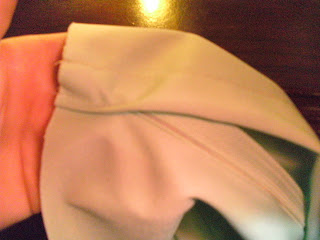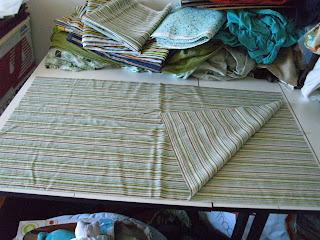Diapers. The inevitable, hated part of child-rearing. You show someone an adorable infant, complete with drooly grin, tiny baby hands, and that "new baby" smell, and at some point someone will mention, "yeah, but I'm not changing it..."
Hubby and I have decided we would like to cloth diaper. I haven't yet settled on a brand or style of cloth diaper (mostly because its such a huge financial investment and I demand perfection in every product I buy - a completely unrealistic goal), so I am focusing on the diaper pail/wet bag thing for now.
A friend of mine cloth diapered, but when she was out and about with baby, she used disposables. Totally understandable. But for me, who goes out only rarely, and even then only short trips to the grandparents for dinner, church on Sunday, or to the grocery store, I would like to try bringing cloth diapers with me. For longer trips (a full day/many days) without access to a washer and an easy diaper storage solution, I think I may just murder the environment a little, but for those quick couple-of-hour trips to visit a friend or do a little shopping, I would like to give it a good try. Of course, this begs the question "What the heck am I supposed to do with a few hours worth of dirty diapers that I can't just toss in the garbage?" The answer? Wet bags.
Wet bags are waterproof bags with a zipper or drawstring opening that go in a diaper bag and hold all the messies. The idea is that they 1) contain wetness, 2) contain odor, and 3) are roomy enough to hold a few diapers, but small enough to be portable. Some have other bells and whistles like hanging straps to snap to a stroller or something, extra pouches for dry items, either zippered or mesh, coordinating paci carriers and other accessories, a zippered bottom for easy emptying into a washer (especially for larger ones that would be sent to daycare or something), the list goes on and on.
In the course of my research, I found that my favorites fell into two distinct categories:
1) The smallish bags that could hold about 4 diapers and tucked easily into a diaper bag. They had things like pouches for clean diapers, wipes, a changing pad, and butt cream so it could be an all in one diaper solution, and straps to wrap around a wrist or stroller handle. They had one opening only and could be either a zipper or a drawstring (usually elastic) and toggle. I saw this as the ultimate solution for my travel dilemma, as well as an easy alternative to a whole diaper bag for outings where less is more, like theme parks or zoos. This could easily get tossed into my purse and keep everything I needed for routine changing within easy reach.
2) The oversized bags that were often marketed as diaper pail liners, if not diaper pail alternatives. They hold 20 some diapers (often even more), usually have two openings, one at the top for putting them in, and a large opening at the bottom for dumping them into the wash, and have handles or hangers to loop over a doorknob, dresser drawer knob, or some other furniture item. They are somewhat wider than they are long so they hang at about waist height and don't hit the ground, but still have a large enough volume for about 2 days worth of diapers. They tended to have more zipper openings than drawstrings as the drawstrings cinch closed too tightly when the bag is full and heavy (assuming it is hung by the drawstring). Some had open tops that just had elastic around it to keep it from flopping open or to keep it snug in a diaper pail as a liner. I saw this as my ideal nursery dirty diaper storage solution. I have been hating all the diaper pails I have seen because they are not designed for cloth and often have expensive, non biodegradable liners. The wet bags can be tossed in to the wash along with the diapers (to avoid touching them again - ick) and offer a simpler, cheaper solution to handling those diapers. Of course, being eco friendly is super important to me, but I am a cheapskate at heart. After all, that is what this whole blog is about, right? :-)
Both were perfect to suit my needs, albeit very different needs. There are certain challenges I need to overcome before I endeavor to make them, though. (Sorry, I appear to be a fan of numbered lists today):
1) How to make them definitively waterproof.
Even commercial bags often have complaints about leakage. Some can be chalked up to leaving liquid in the bag, which it isn't always designed to do. For example, zippers are not made of waterproof material and may leak, and a drawstring closure may not be tight enough to keep in moisture. I'd like to make mine leakproof enough to hold rinsed poopy diapers, but not necessarily able to hold water. Many bags reinforce/enclose seams to prevent leaking and wicking. I think this is a good strategy.
2) What kind of material to use.
PUL is the obvious choice, but even that leaves some wiggle room. I have some from a local fabric store, but I have read time and again that this is not "real" PUL. Also, nylon, polyester, and a few other materials were commonly used. Some bags had a waterproof inner liner and a soft, pretty outer shell. This would be good for adding pockets, which may wick moisture if sewn into the same side seams, but also makes the items much more time and materials intensive. Not sure how to tackle that.
3) Which bells and whistles to include and which to leave off.
I liked the idea of a pocket on the small bag, but maybe I will only make one with pocket(s). I initially thought of this as something to toss into the larger diaper bag, which would make the extra pocket redundant. However, as a grab and go mini-diaper bag, it would be handy storage. I also kind of want a snap strap, but I can't for the life of me think why it would be useful since I wouldn't dangle this from my stroller. Ever. But the appeal is there... Also, how to make the large bag hang is a concern of mine. I don't have a lot of nursery furniture (or space) and while I want it to be easy to access, I don't want it in the way on the front of a drawer or something. On the door is too far away - I'd have to leave baby alone on the changing table and walk across the room to the door. Unacceptable... This may take some real thought. Or a freestanding structure to hold it, similar to a hamper. Hmmm...
4) What kind of closure(s) to use.
I am pretty much sold on the zippered small bags, but the large bags have me in a tizzy. The large bags sometimes had no closure at the top to ease the dropping in of diapers. I heard that open bags work well for cloth diapering, but I am hesitant to actually try it after being in my friend's nursery which smells like ammonia. Maybe a drawstring top? But then putting diapers in will take 2 hands... I think I will have to invent a solution. Maybe an "open" top that overlaps to prevent airflow but is easy to drop in dirties? This also may discourage curious toddler hands from pulling out diapers later on...
At any rate, there are lots of things to think about, but I do believe this will be my next major project.
Also coming up will be some reusable nursing pads. I think I started leaking yesterday! Its crazy and weird and embarrassing, but exciting at the same time. I had a wet spot on my tee shirt right where my right nipple hit when I got up from spooning hubby. I wasn't wearing a bra because we were just playing video games in the living room on the fold out couch bed, avoiding the rest of the world for Labor day, and there it was, a small dot of moisture. Its possible it came from somewhere else, but as I was spooning him, I can't imagine how. My grandmother likes to tell stories about how she sprayed milk in the shower when pregnant and nursing my father. (She jokes that she didn't know it was unusual since it was her first child.) I suppose that means I have a genetic predisposition to leakage. If there is such a thing (genetic predisposition I mean, not leakage). Using Nana's method of cutting up maxi pads to stuff in a bra doesn't appeal to me, so I will figure out how to make some. I'm sure I can double up that research with making diaper soakers as the principle is much the same - soak up liquid with as little thickness as possible to do the job. Look forward to that...
 Threading a ribbon/elastic/other through a casing:
Threading a ribbon/elastic/other through a casing:

















































